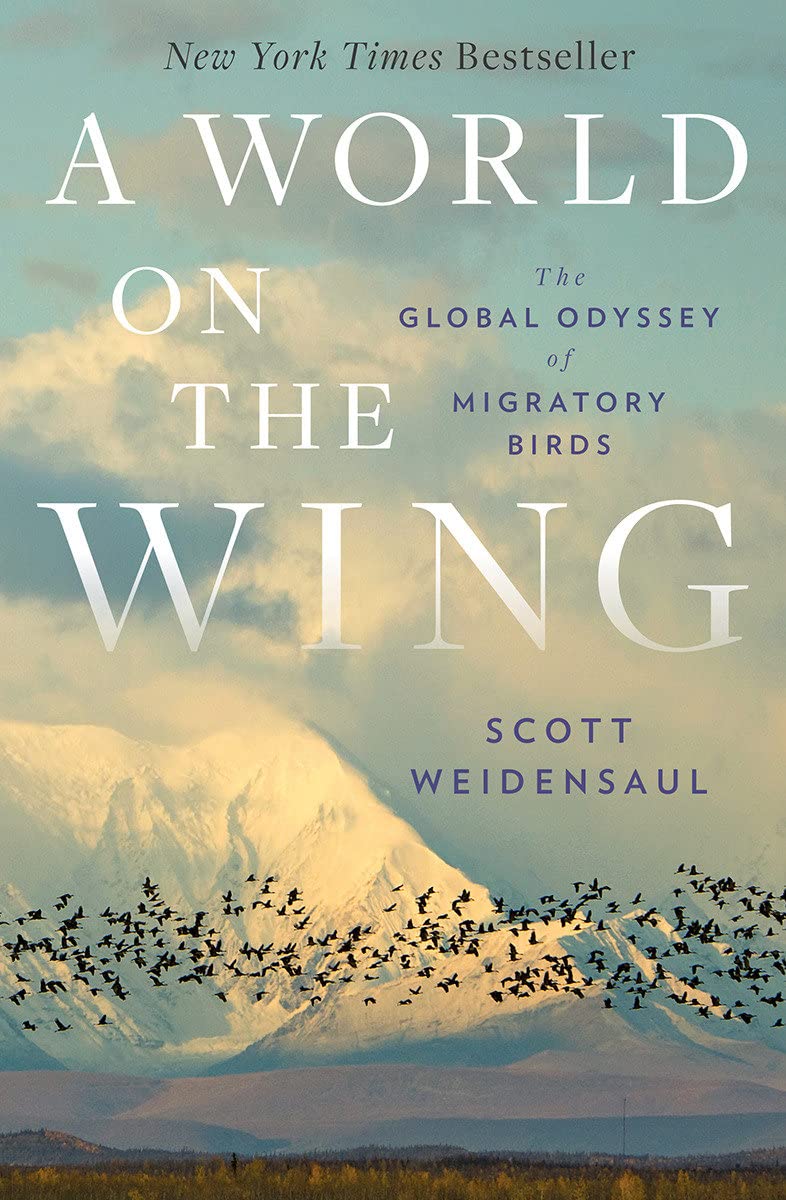Researchers have found that in advance of their flights, migrant birds can bulk up with new muscle mass without really exercising, something humans would love to copy. Because a bird’s muscle tissue is all but identical to a human’s, the trigger must be biochemical, but remains a tantalizing mystery. They also put on so much fat (in many cases more than doubling their weight in a few weeks) that they are, by any measure, grossly obese, and their blood chemistry at such times resembles that of diabetics and coronary patients—except that they suffer no harm.
==========
And just to cap that, three years later researchers who had tagged Arctic terns in the Netherlands found that those birds were traveling up to 57,000 miles a year, reaching the waters off Australia and using staging areas in the Indian Ocean (where, it turns out, tagged terns from the coast of Maine also gather).
==========
Leaving northwestern Australia, the knots make a single nonstop flight of more than 3,400 miles to China and the Koreas, during which they burn through their entire fat reserves, while cannibalizing their own muscle and organ tissue to feed the enormous energy demands of their continually pumping flight muscles. By the time they arrive on the Yellow Sea, almost all of their internal organs have withered from exertion as the body catabolizes itself; only the brain and lungs appear to be unaffected by the marathon, while organs like the intestines and salt glands, which are of limited use during a long flight anyway, shrink the most.
==========
When in 2019 an Ethiopian athlete set a new record by running a marathon in less than two hours, it was routinely described as “superhuman.” Perhaps, but also subavian. That semipalmated sandpiper that flew from subarctic Canada to the jungle delta of the Orinoco managed the equivalent of running 126 consecutive marathons, and at a metabolic rate several times greater than even an elite human runner can achieve. Again: six inches long, and not even an ounce in weight.
==========
Migratory birds can grow and jettison their internal organs on an as-needed basis, bolster their flight performance by juicing on naturally occurring performance-enhancing drugs, and enjoy perfect health despite seasonally exhibiting all the signs of morbid obesity, diabetes, and looming heart disease. A migrating bird can put alternating halves of its brain to sleep while flying for days, weeks, or even months on end, and when forced to remain fully awake has evolved defenses against the effects of sleep deprivation; in fact, birds actually seem to get mentally sharper under such conditions, the envy of any human slogging through the day after a poor night’s sleep.
==========
If all that isn’t sci-fi enough, we now know that they navigate using a form of quantum mechanics that made even Einstein queasy.
==========
Twenty years ago, scientists employing some of the first miniaturized satellite transmitters were stunned to learn that many godwits make a 7,200-mile nonstop flight each autumn from western Alaska to New Zealand, a journey that takes them eight or nine days of uninterrupted flight—the longest nonstop migration known, exercising at the same metabolic rate as a human running endless four-minute miles. They accomplish this astounding feat by first larding themselves with thick layers of fat, feeding with manic energy on the rich tidal flats of the Alaskan Peninsula, eating marine worms and other invertebrates. They more than double their weight in about two weeks, so that a 1.5-pound godwit is carrying more than 10 ounces of fat under its skin and within its body cavity. So obese that they jiggle when they walk, the godwits then undergo a rapid reorganization of their internal anatomy. Digestive organs like their gizzard and intestines, which they no longer need, shrink and atrophy, while the pectoral muscles that power their long, slender wings double in mass, as does their heart muscle, and their lungs increase in capacity. (Like so many discoveries involving shorebirds, this one was made by Theunis Piersma, working with American scientist Robert Gill Jr. from the US Geological Survey.)
==========
By any typical measure, a migratory bird ready for travel ought to head to the ER, not the skies. “By human standards, premigratory birds are obese, diabetic, and likely to drop dead of a heart attack at any moment,” in the words of two researchers studying this phenomenon. How birds protect themselves is still a mystery, but researchers hope that insights from avian physiology may help unlock new treatments and preventive approaches in people.
==========
Each dove has an onboard compass to direct it, and each bird’s directional sense is, to a greater or lesser degree, somewhat inaccurate. No one’s perfect, but by flying together, the doves average out their inaccuracies and arrive at a better, more precise collective decision than any one of them could produce alone. This is known as the “many wrong” theory (as in, many wrongs make a right), and it’s the same kind of wisdom-of-crowds effect that can, as was first noted in 1906, lead hundreds of English fair-goers to correctly guess the weight of an ox to within 1 percent of the actual figure, when all their guesses are averaged.
==========
We know that they use a variety of cues, including landscape features like mountain ridges and coastlines; stellar guideposts like the stars (not the stars’ position and pattern in the night sky, but their apparent lack of rotation around Polaris that indicates north), the movement of the sun across the sky, and the concurrent shift of bands of polarized light that are invisible to us but easily seen by birds; even “odor landscapes” of volatile chemicals that remain remarkably stable across hundreds of square miles, despite wind and weather, and remain so from season after season—sniffable road signs on the migratory highway. Perhaps the most important of these migratory cues, but for many decades also the most mysterious, is magnetic orientation.
==========
Three years later, scientists announced that common swifts, similarly tagged in Sweden, spent fully 10 months on the wing in their west African wintering grounds—confirming a suspicion about that species that some naturalists had expressed dating back almost a century.
==========
Beyond the impact on eastern woodland species, scientists dug into the effects of fragmentation globally and were horrified by what they found: worldwide, 70 percent of all remaining forest lay within a kilometer of an edge, and habitat fragmentation overall reduces biodiversity by up to three-quarters.
==========
…even a small intrusion, like a dirt road, can allow cowbirds to penetrate woodland and parasitize nests.
==========
Interestingly, in southern British Columbia there are a few valleys where both the rusty coastal form and the olive-backed inland thrushes occur together—and hybridize. Because migration is largely instinctive, written into a bird’s DNA, it’s not surprising that their hybrid offspring have warring genes that appear to tug them in contradictory directions. Thanks to geolocators, we know that some hybrids split the difference and follow an intermediate route—a poor choice and a challenging one, taking them over rugged mountains and deep deserts with few chances to rest and feed. Other hybrids may in the fall follow an inland-type route, inherited from one parent, swinging far to the east and south, but in spring use a coastal-type route inherited from the other parent, looping all the way to the Pacific before heading north. Or the reverse. Not surprisingly, given the extra trials and distance their bastardized navigation puts them through, the hybrids remain uncommon, maintaining the genetic divide between the two subspecies groups, and reinforcing each form’s unique migration connectivity.
==========
(Similar challenges face European warblers known as blackcaps, where a migratory divide in Austria and the Czech Republic splits the population, one side migrating southwest to Iberia, the other around the eastern Mediterranean. Hybrids inherit a tough-luck map that sends them across the Mediterranean and into the Sahara.)
==========
Since 1970, some 3.2 billion birds—almost 30 percent of the continent’s total breeding population—have disappeared from North America, a reduction that was almost perfectly reflected in a similar decline in nocturnal bird migration captured in the radar archive. The losses were heaviest in the East, where the birdlife is dominated by migrants traveling between the tropics and temperate or boreal forests.
==========
The altered calendar produces winners and losers. In the UK, arrival dates for 11 of 14 species have advanced by up to 10 days since the 1960s, with the biggest change among short-distance migrants that winter in southern Europe or northern Africa; many have also extended their stay in autumn so that their time in Britain has lengthened significantly.
==========
A reduction in body size actually appears to be a near-universal response to climate warming, and has been shown in a wide variety of animals, from salmon to squid and salamanders to ground squirrels.
==========
On the Scandinavian peninsula, lemming cycles broke down beginning in 1994 and didn’t recover for two decades, during which both snowy owls and Arctic foxes largely disappeared there; in northeastern Greenland, the same thing happened to lemmings starting in 1998 and remains so. In other parts of the Arctic, like Wrangell Island in the Russian Far East, lemming cycles haven’t collapsed, but they have stretched—from every four years to every eight, meaning snowy owls in those regions can breed less often.
==========
As they soar effortlessly on the perpetual sea wind, distance is essentially meaningless to the tubenoses, whose travels connect incredibly distant pockets of tremendously abundant food. A wandering albatross, with 11-foot-wide wings the largest of them all, may during its so-called “sabbatical year” between biennial breeding attempts fly 74,000 miles, circumnavigating Antarctica two or three times without ever seeing land. The pelagic seabirds chase oceanic riches that swell and diminish with the changing seasons, while returning once every year or two to land—almost always on some flyspeck island or remote archipelago insulated from predators by distance from any mainland—where they spend the bare minimum required by biology to lay an egg (always just one) and raise a chick. They compensate for this extremely low reproductive rate by living a long time; the oldest known wild bird of any species is a Laysan albatross named Wisdom, banded in 1956 as an adult and, at the age of at least 69, still returning to Midway Atoll in the Hawaiian chain each year to nest.





Díky za tip.
Je to fakt dobrá knížka, teď jsem ještě nějaké výpisky přidal. Já se docela zajímám o ptactvo, tak je to pro mě obzvlášť super.